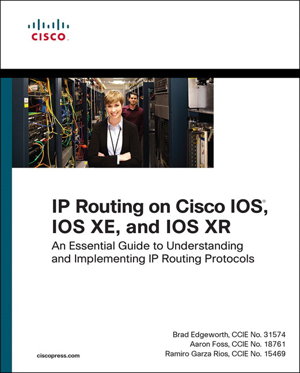
PublishedCisco Press, December 2014 |
ISBN9781587144233 |
FormatSoftcover, 1152 pages |
Dimensions23.3cm × 18.9cm × 5.9cm |
An Essential Guide to Understanding and Implementing IP Routing Protocols
Cisco's authoritative single-source guide to IP routing protocols for enterprise and service provider environments
Service providers and large enterprises are converging on a common IP infrastructure that supports rapid deployment of high-value services. Demand is soaring for highly skilled IP network engineers who can implement and run these infrastructures. Now, one source combines reliable knowledge about contemporary IP routing protocols and expert hands-on guidance for using them with Cisco IOS, IOS XE, and IOS XR operating systems.
After concisely reviewing the basics, three Cisco experts fully explain static routing, EIGRP, OSPF, IS-IS, and BGP routing protocols. Next, they introduce advanced routing with policies and redistribution, sophisticated BGP-based traffic engineering, and multicast. They present comprehensive coverage of IPv6, from its multicast implementation to its completely revamped address structure. Finally, they discuss advanced high availability techniques, including fast routing convergence.
IP Routing on Cisco IOS, IOS XE, and IOS XR presents each protocol conceptually, with intuitive illustrations, realistic configurations, and appropriate output. To help IOS users master IOS XE and IOS XR, differences in operating systems are explicitly
identified, and side-by-side feature command references are presented.
All content fully aligns with Learning@Cisco, providing efficient self-study for multiple Cisco Career Certifications, including CCNA (R)/CCNP (R)/CCIE (R) Service Provider, CCIE Routing & Switching, Cisco IOS XR Specialist Certification, and the routing components of several additional Cisco Certifications.
Brad Edgeworth, CCIE No. 31574 (R&S & SP) has been with Cisco since 2011 as Systems Engineer and Technical Leader. Formerly a network architect and consultant for various Fortune (R) 500 companies, his 18 years of IT experience includes extensive architectural and operational work in enterprise and service provider environments. He is a Cisco Live distinguished speaker presenting on IOS XR.
Aaron Foss, CCIE No. 18761 (R&S & SP), a High Touch Engineer with the Cisco Focused Technical Support (FTS) organization, works with large service providers to troubleshoot MPLS, QoS, and IP routing issues. He has more than 15 years of experience designing, deploying, and troubleshooting IP networks.
Ramiro Garza Rios, CCIE No. 15469 (R&S, SP, and Security), Senior Network Consulting Engineer with Cisco Advanced Services, plans, designs, implements, and optimizes next-generation service provider networks. Before joining Cisco in 2005, he was Network Consulting and Presales Engineer for a Cisco Gold Partner in Mexico, where he planned and deployed both enterprise and service provider networks.
Foreword by Norm Dunn, Senior Product Manager, Learning@Cisco Global Product Management, Service Provider Portfolio
Understand how IOS (R), IOS XE, and IOS XR operating systems compare
Master IPv4 concepts, addressing structure, and subnetting
Learn how routers and routing protocols work, and how connected networks and static routes behave from the router's perspective
Work with EIGRP and distance vector routing
Deploy basic and advanced OSPF, including powerful techniques for organizing routing domains, path selection, and optimization
Compare IS-IS with OSPF, and implement advanced IS-IS multilevel routing, optimization, and path selection
Make the most of BGP and route manipulation, including IOS/IOS XE route maps and IOS XR's highly scalable Route Policy Language
Use advanced policy-based route manipulation and filtering
Implement route redistribution: rules, potential problems, and solutions
Leverage BGP communities, summaries, and other router conservation techniques
Discover how IPv6 changes IP address and command structure
Establish highly efficient multicast routing in IPv4 and IPv6 environments
Systematically improve network availability and operational uptime through event driven detection and fast routing convergence

